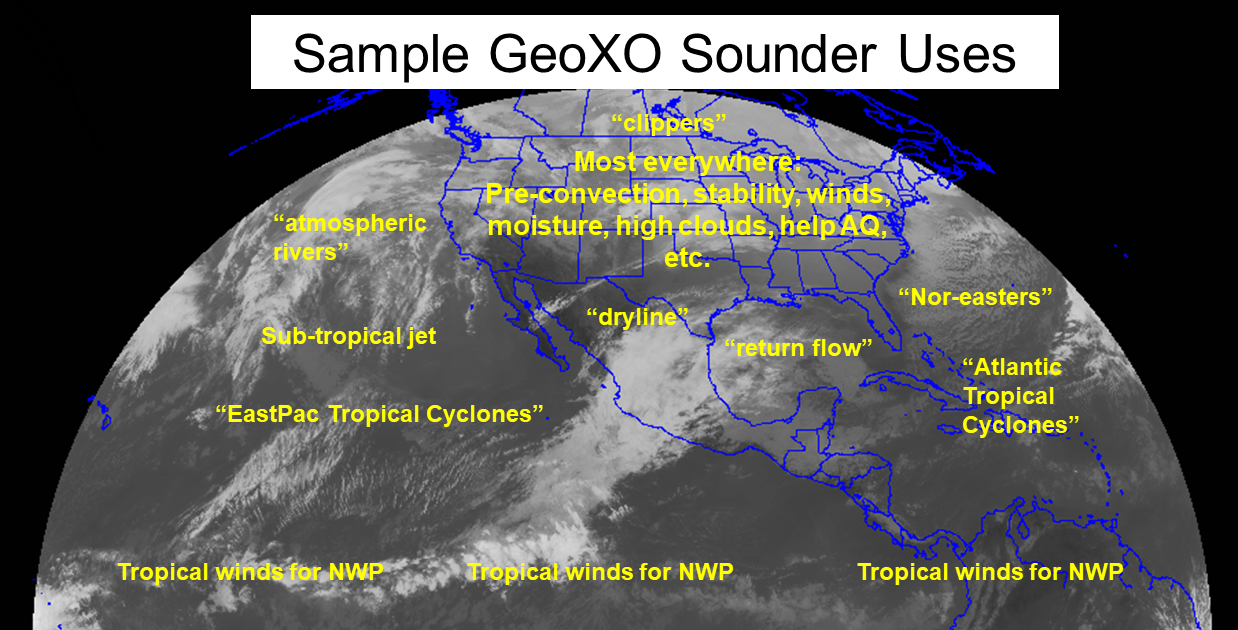
[ Archive ]

 |
CIMSS-NOAA Weekly Report [ Archive ] |
 |
CIMSS AND ASPB WEEKLY HIGHLIGHTS FOR THE WEEK ENDING MARCH 25, 2022
DATA, INFORMATION, AND USE-INSPIRED SCIENCE:
FUTURE OUTLOOK:
AWARDS AND RECOGNITION:
TRAVEL AND MEETINGS:
International TOVS Working Group (ITWG) Interim Working Group Meetings: International TOVS Working Group (ITWG) Interim Working Group Meetings were held over the past few weeks. Cooperative Institute for Meteorological Satellite Studies (CIMSS) scientist David Tobin co-chaired the Advanced Sounder Working Group (ASWG) meeting on 24 March and CIMSS scientist Graeme Martin co-chaired the Products and Software Working Group (PSWG) meeting on 23 March. A wide range of issues relating to these topics were presented and discussed. From the ASWG a draft recommendation consistent with the World Meteorological Organization (WMO) Integrated Global Observing System (WIGOS) 2040 Vision was put forth: "ITSC-24 ASWG recommends to NOAA that high priority be given to implementing the WIGOS 2040 backbone by (1) Adding advanced IR sounders in 3 new sun-synchronous orbits to provide 2-hour global sampling for improved dynamics/3-D winds, and (2) Contributing to achieving a 5 Geo-IR sounder ring with synchronized contiguous coverage to provide the global sampling needed to observe 3-D winds, small scale tropical convective storms, and the atmospheric river moisture transport responsible for mid-latitude precipitation events." In the next month reports from the ITWG Interim Working Group Meetings will be compiled and presented to the ITWG Chairs for review and presentation to the Coordination Group for Meteorological Satellites (CGMS). (D. Tobin, CIMSS, 608-265-6281, G. Martin, CIMSS, 608-263-6794)
GeoXO Sounder Presentation: On March 21, 2022, T. Schmit gave a presentation titled "A Brief Introduction to the Geostationary Extended Observations (GeoXO) Sounder (GXS)" at the Sounding Initiative Teleconference. Historically the group focuses on sounding applications from polar-orbiters, so this was a chance to consider future enterprise solutions. More on the GeoXO Program: https://www.nesdis.noaa.gov/next-generation/geostationary-extended-observations-geoxo. (T. Schmit, E/RA2, 608-263-0291)
 (Click image to enlarge)
(Click image to enlarge)
Figure: Sample future uses of the Geostationary Extended Observations (GeoXO) Sounder observations.
TRAINING AND EDUCATION:
CIMSS Scientists Participate in IMET Training: On March 8-10 and 24, Cooperative Institute for Meteorological Satellite Sciences (CIMSS) scientists William Straka and Chris Schmidt participated in hybrid virtual and in-person training on Geostationary Operational Environmental Satellite (GOES) Advanced Baseline Imager (ABI) and Joint Polar Satellite System (JPSS) Visible Infrared Imaging Radiometer Suite (VIIRS) fire and smoke products during the Incident Meteorologist Continuity of Excellence Exercise (IMET CEE) that was held in Boise, ID. The training provides IMETs with an introduction to, and education about, fire and smoke products from NOAA that can assist them during fire events. It was organized as part of the the Fire and Smoke Proving Ground and included participation by other scientists connected to the effort. (W. Straka III, CIMSS, C. Schmidt, CIMSS, 608-262-7973)
MEDIA INTERACTIONS AND REQUESTS:
SOCIAL MEDIA AND BLOG Posts:
SSEC and CIMSS Scientists in the News: Scientists at the University of Wisconsin-Madison (UW) Space Science and Engineering Center (SSEC) and the Cooperative Institute for Meteorological Satellite Studies (CIMSS) provide expert interviews, imagery and case studies to promote science. This week, CIMSS Satellite Blog contributors Scott Bachmeier, Scott Lindstrom, John Cintineo and Tim Schmit published these case studies: "Potential Vorticity anomaly over Texas and Louisiana" (Mar. 24), "Hyperspectral modeling during severe weather" (Mar. 23), "Severe thunderstorms across the Deep South" (Mar. 22), "Forecasting storms with AI" (Mar. 22), "Using McIDAS-V to display GOES-16 FDCA fields" (Mar. 22), "The coming geo2grid update will include level 2 product support" (Mar. 21), "Fall to Spring Equinox 2022" (Mar. 20), "Satellite signatures of moist soil (and patches of snow cover) across Iowa" (Mar. 19), and "How to access Himawari imagery in real time" (Mar. 18). Read more at the CIMSS Satellite Blog: https://cimss.ssec.wisc.edu/satellite-blog/. (S. Bachmeier, CIMSS, S. Lindstrom, CIMSS, J. Cintineo, CIMSS, T. Schmit, E/RA2, J. Phillips, SSEC, 608-262-8164)
(Click image to enlarge)
Figure: NOAA and CIMSS are using satellite, radar and lightning observations of thunderstorms to develop artificial intelligence tools that forecast and diagnose convection. Among them is ProbSevere LightningCast that uses GOES-16 or -17 ABI data to predict where lightning will strike out to 60 minutes. Read more at the CIMSS Satellite Blog: https://cimss.ssec.wisc.edu/satellite-blog/archives/45353. Credit: CIMSS, NOAA.
 (Click image to enlarge)
(Click image to enlarge)
Figure: GOES-16 imagery highlights soil moisture (darker green) across central and southeastern Iowa as well as fresh snow cover (red shades), southwestern Iowa, after precipitation on Mar. 19, 2022. Read more at the CIMSS Satellite Blog: https://cimss.ssec.wisc.edu/satellite-blog/archives/45307. Credit: CIMSS, NOAA.
PUBLICATIONS:
OTHER:
| Archived Weeklies Page | Submit a report item |